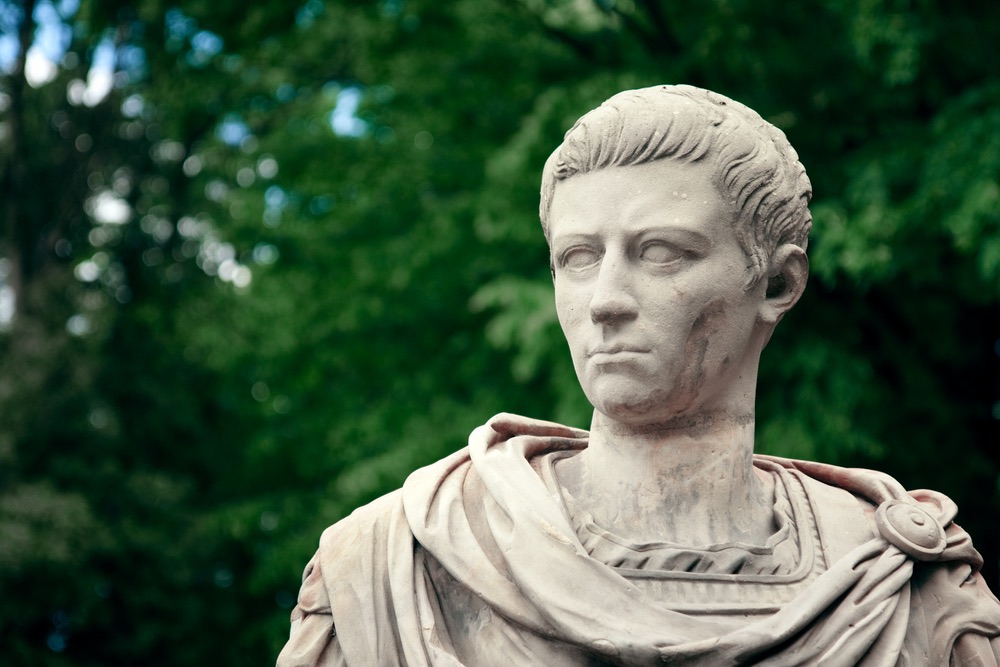Search Begins for Roman Emperor's Legendary Party Ships

Italian researchers are about to reveal whether a volcanic lake in central Italy hides one of the legendary "orgy ships" of Roman Emperor Caligula.
If successful, the archaeological feat would produce one of the most extraordinary discoveries of recent times.
Gaius Julius Caesar Augustus Germanicus (A.D. 12 to A.D. 41), best known by his nickname Caligula (Little Boots), was the third emperor of the Roman Empire.
Although there have been attempts to rehabilitate him, many historians believe he was the most lunatic, sadistic, and tyrannical emperor in Rome's history. During his brief but wild reign from A.D. 37 to A.D. 41, he is said to have committed incest with each of his three sisters, not to mention making his favorite horse Incitatus a consul and proclaiming himself a living god.
One of his capricious whims was to have monumental ships built so that he could indulge his sexual proclivities on the scenic Lake Nemi, some 20 miles outside Rome.
The ships were most likely scuttled in a "damnatio memoriae" (an action aimed at erasing someone from history) 2,000 years ago, after the 28-year-old emperor was murdered in his palace on Rome's Palatine Hill by members of the Praetorian Guard who were enraged by his cruelty and excess.
The luxury ships disappeared from history, but their legend has persisted throughout the centuries.
Sign up for the Live Science daily newsletter now
Get the world’s most fascinating discoveries delivered straight to your inbox.
Indeed, two wooden ships, one measuring 230 feet in length, the other 240 feet, were first spotted at the bottom of the lake in the 15th century. They were finally brought to light in the late 1920s under Italian dictator Benito Mussolini, who ordered the lake to be partially drained.
Unfortunately, nothing remains of the ships, as they were torched under mysterious circumstances.
But Caligula's ships are difficult to forget: Rumors persisted about Mussolini leaving behind a third, 400-foot-long pleasure vessel.
To solve the boat mystery once and for all, authorities in Italy have mounted an in-depth search, which involves researchers from the Environmental Protection Agency of Calabria, Carabinieri divers of Rome, Port authorities of Fiumicino, Rome, and ISPRA, the Italian National Institute for Environmental Protection and Research.
"The survey actually began as a search for illegal dumping," said Luigi Dattola, at the Environmental Protection Agency of Calabria.
"It was then decided to dive further and search for the mysterious ship," he added. "Although it might seem bizzarre that three huge ships would float upon such a small lake, the fact the vessels belonged to Caligula makes the scene likely."
RELATED: Artifacts Revealed in Tomb of King Henry VII: Photos
Dattola scoured last month the 100-foot-deep lake with high-tech scanners. The equipment was necessary as the condition of the lake doesn't allow divers to search for submerged wrecks.
"It takes several hours for the mud particles to deposit as divers move their fins down there. And even then, the visibility is really low, less than three feet," Dattola said.
Dattola's team used side-scan sonar to scour the waters of the lake and sub-bottom profiling systems, which are able to detect objects buried up to 9 feet below the muddy bottom.
Overall, the two-week survey produced enough material to keep the researchers busy with analysis until the end of June.
"We have already noticed some anomalies," Dattola said. "They will be investigated by the Carabinieri divers in the next days."
He stressed these preliminary dives are unlikely to reveal the presence of the legendary ship, but might unveil other archaeological features.
Today Nemi is synonymous with strawberries, but in Roman times this tiny village in the Alban Hills was the center of one of antiquity's cruelest religious rites: a regular human sacrifice performed in honor of the local divinity, Diana Nemorensis, also known as Diana of the Woods.
As the Roman counterpart of the Greek goddess Artemis, Diana had a sanctuary on the northern shore of the lake managed by a high-priest known as Rex Nemorensis, the "King of the Sacred Grove."
The priest-king could be displaced only by a slave who had managed to cull a branch from a sacred oak tree in the grove, which earned him the right to fight the reigning leader to the death, and step straight into his place.
This violent rite of succession dominated Nemi's grove at Caligula's time.
According to historic accounts, the megalomaniac emperor dedicated himself to religious rites — and orgies — while on the ships.
RELATED: Christ's Tomb at Risk of ‘Catastrophic' Collapse
As they emerged from the muddy depths in the late 1920s, the ships looked like two great barges, but some details, such as exquisite wolf heads adorning the end of the beams and decks covered with marble and mosaics, clearly indicated the galley was a triumph of luxury and grandeur.
Indeed, the Roman historian Suetonius wrote the vessels had "sterns studded with gems and ample space for baths, porticoes, and dining rooms, and a great variety of vines and fruit-bearing trees."
Reclining on these ships all day long, Caligula "would sail amid choral dancing and singing."
Floating upon the small volcanic lake, the gigantic ships were clearly stationary. Nevertheless, lead pipes, piston pumps, and other sophisticated mechanisms in the wrecks recovered during Mussolini's time showed advanced nautical engineering.
Finding the third ship, which according to the local mayor Alberto Bertucci would be the "world's first luxury cruise ship" will add useful information about the naval construction techniques of the Romans.
Hope for the existence of the fabled vessel lies in a 16th century account by military engineer Francesco de Marchi who descended to the lake bottom using a kind of diving bell.
Bertucci told reporters de Marchi brought up relics "on the far side of the lake from where the two other boats were found, and talked of a boat measuring up to 400 feet long."
De Marchi's account appeared to be confirmed by local fishermen who caught Roman artifacts in their nets as they fished in that area of the lake.
"According to rumors, the third boat would lean by the west coast of the lake below the town of Genzano," Dattola said.
Intriguingly, that area of the lake wasn't drained by Mussolini.
Dattola found evidence of several landslides there, which occurred in antiquity and after the lake draining.
"We focused our survey particularly on that area," Dattola said. "If the ship is there, we should be able to see it."
RELATED: Huns and Farmers Swapped Cultures in Harmony as the Roman Empire Crumbled
Original article on Seeker.










